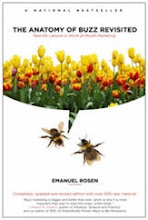 A lot of buzz comes not from clever PR or advertising but rather from attributes inherent in the product or service itself. I call products that have such built-in buzz “contagious products”. Here are eight low-tech examples:
A lot of buzz comes not from clever PR or advertising but rather from attributes inherent in the product or service itself. I call products that have such built-in buzz “contagious products”. Here are eight low-tech examples:1. Magnetic Poetry. Some products self-propagate by leaving traces of themselves behind. This is especially true for products that allow their users to express themselves. Magnetic Poetry spread this way. People saw bizarre messages on their friends’ refrigerators and started playing with the magnets. They left some interesting poems behind and bought their own kit for their fridge (and the one at the office!)
2. Cranium. Social interaction leads to talk. After a night of playing Cranium, you tell your friends how much fun you had, and about all the outrageous things that Chris did with clay and what Linda said and… you spread the word about Cranium.
3. Fresh fruit bouquets. All communication tools have built-in buzz because we use them to interact with others. When you get a fruit bouquet from a friend, you learn about the company behind it (ediblearrangements.com) and you may use them next time you want to surprise someone. (High tech examples: too many to list here. Email, Facebook, etc.)
4. The first Kodak camera. Cameras were invented in the 1820s, but for years they were perceived as too complicated for “the rest of us”. George Eastman reduced the operation to a three-step process: pull the cord, advance the key, and press the button. Their 1888 slogan captured it all: “You press the button—we do the rest.” Products that dramatically simplify something that appears beyond reach, can easily become contagious. (Macintosh)
5. DuPont Tyvek. By using Tyvek’s insulation material, contractors advertise this product to other contractors and homeowners in the area. This type of visual buzz plays an important role in several industries. (e.g. automotive, cell phones, fashion, sports)
6. Financial Times. Visual buzz plays a role here too. The fact that the FT is printed on pink (okay light salmon) paper, distinguishes it from others. In a similar way, distinctive blue bags in driveways tell people that their neighbors read the New York Times. Powerful social learning with no words exchanged.
7. The movie Psycho. Some products become contagious by evoking a strong emotional reaction. After we saw the movie Psycho, my teenage friends and I couldn’t stop talking about the movie. Fear, of course, is an emotion that evokes positive buzz for just a few products, such as horror films. For most products and services, it is usually the feeling of excitement and delight. The Wow effect.
8. FedEx. It’s hard to imagine it today, but there was a time when people did not know about overnight services. The FedEx brand (or “Federal Express” as it was known) spread partially through those distinctive envelopes. But it’s important to note that this initial buzz is usually not enough. It’s conceivable that, in time, almost every office in the world would have received a FedEx letter and thus would have been exposed to the brand. But in real life, with competitors and cash flow issues, companies need to accelerate buzz externally.
I’ll be in London on Monday July 19th to talk about accelerating buzz about contagious products. More details here.









